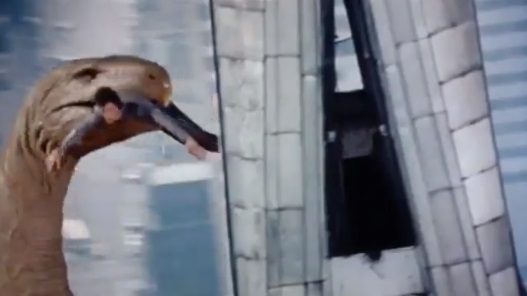“I saved you all, saved the whole fucking city — and what do I get for it, huh?”
There is a monster stalking the city in Q: The Winged Serpent. And it’s not Quetzalcoatl, the Aztec snake god, reborn through blood sacrifice and hungry for flesh. No, this monster is more insidious. It lives inside a man, small-time crook Jimmy Quinn, a man who has the knowledge necessary to stop a beast terrorizing his fellow New Yorkers and sits on it, demanding money in return for saving lives. The real monster of Q is not the winged serpent — it’s human greed.
Ahahahahahahahahahaha I’m fucking with you, the real monster is a giant goddamn flying snake creature that rips apart and devours the people of New York, be they asshole cop, petulant construction worker or merely hardworking pervert. This worm eats every part of the Big Apple! The weirdo cultists who bring him back to life are pretty bad too. On the other hand, that doesn’t make Jimmy a great guy either. He’s a dick to his girlfriend and a shitty criminal and there’s that whole holding the fate of the city for ransom thing.
Roger Ebert had a famous story about Rex Reed meeting Q producer Samuel Z. Arkoff, god-level orchestrator of low-budget crap. Reed had just seen Q and told Arkoff, “What a surprise! All that dreck — and right in the middle of it, a great Method performance by Michael Moriarty!” To which Arkoff, not missing a beat, replied, “The dreck was my idea.” Reed, as usual, missed the point. Moriarty’s performance as Jimmy is great — he’s an off-key tuning fork, vibrating his weirdness constantly into the film around him — but he’s also playing dreck, a kicked-around and defiant guy who’s going to have his day, Goddammit. A kindred spirit with Q’s writer/director, Larry Cohen.
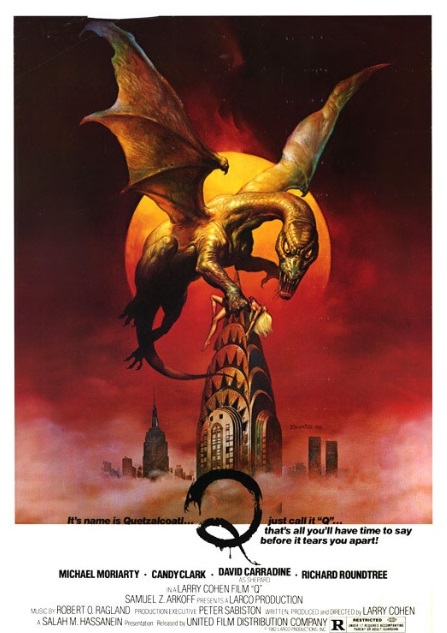
Cohen died earlier this year after a long career making B-movies with frequent horror leanings. The ‘70s to mid-’80s were his peak, and his set was wherever he wanted to film. The trivia for Q on IMDB is just as entertaining as the movie — Cohen apparently wrote the film in six days after getting kicked off a big-budget adaptation of I, The Jury, not wanting to waste the hotel room he’d rented. As per his usual MO, Cohen would fire off blanks without permits (passers-by did not give a shit). He hired real-life steeplejacks — repairmen for skyscrapers — to shoot those blanks from the top of the real-life Chrysler building, and hired the real-life window-washer for the Empire State Building to wash the building’s windows on film before getting beheaded. That last part pretty much has to be true. The movie opens with the guy squeegeeing the glass and ogling a woman’s ass (she recognizes him as a perv straight off) and there’s an extremely casual shot of him on his harness that appears to have been obtained by leaning out a neighboring window and looking over — that is a dude, he is 40 stories up, we are not screwing around here. Much of the film is set on the top of the Chrysler building, where our winged serpent is nesting, and that is where Cohen shoots, only using another set when his giant prop monster egg was too big to fit up there. This is a movie about a stop-motion Aztec god — dreck, to some — and Cohen makes it more real than 95 percent of movies set in the city.
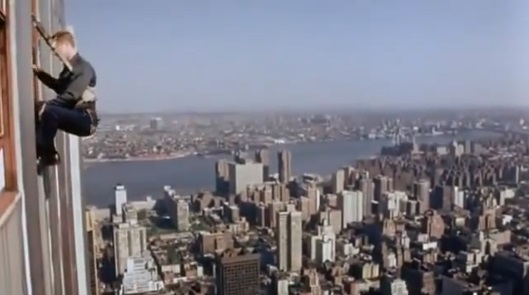
“Maybe his head got loose and fell off, whaddaya want from me?” That’s Detective David Carradine, investigating the Case of the Decapitated Creepo Window Washer that kicks off the movie. He and fellow cop Richard Roundtree are baffled by the rash of gory deaths plaguing the city. To be fair, it’s not like the killer has a pattern — one day’s it’s our sleazebag washer, the next it’s a rooftop sunbather who has just spent a full 30 seconds lovingly oiling her naked breasts. These deaths are preceded by some classic Cheap Monster POV shots, which keep the effects out of the frame, but they have verve and personality. Somehow Cohen — the guy who, when filming a taxi driving on the sidewalk in Black Caesar just drove a taxi up on the sidewalk without telling anyone beforehand — got his mitts on a helicopter, and he shoots his aerial footage with the same nonchalant abandon as his window-washing shots, lingering over the tops of buildings and moving through the city with the confidence of a real flying creature, letting his gaze move with the focus of something feral and hungry. There’s none of the sterile equilibrium of a drone here.
For boring stuff, we sadly have Exposition Museum Workers Who Are Totally Evil, yakking Carradine’s ear off about what exactly a Quetzalcoatl is and how there’s no reason to anthropomorphize God, who could totally be a flying snake if you think about it, and maybe you could pray good old Q back into existence, blah blah blah. This could potentially be interesting but Cohen doesn’t give it his full attention (and he dealt with religion a few years earlier in the much stranger and darker God Told Me To, about people going on shooting sprees in NYC because see title). He plunks most of this in the first half of the movie, which runs the risk of making viewers tune out early on. But it pays dividends as the rest of the movie has more time to focus on Moriarty.
We meet Moriarty as he agrees to drive for some jewel heisters, but we find out who he is in his second scene, where he walks into a bar and asks if he can play their piano in the early evening. “I don’t work the piano like ROCK SINGERS!” he blusters, and it turns out he doesn’t — Moriarty is clearly playing and singing himself, a formless and scat-heavy but not bad vamp called “Evil Ways.” The bartender responds by plugging in the jukebox. Carradine is in the bar grabbing a drink and tells Moriarty “Sounded OK to me,” to which Moriarty responds “Yeah, what the fuck do you know?”
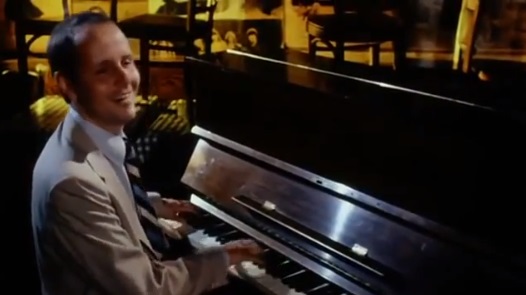
As even a professional dipshit like Reed could see, Moriarty is magnetic — a twitchy ex-junkie with a ton of big talk and no real self-esteem, someone whose words spill out of him and never quite land on the beat you’d expect. He’s a guy who’s done time for legit crimes and because cops planted dope on him. “Maybe I’m still an institutionalized person,” he moans to girlfriend (and that is pretty much all she is), Candy Clark. But he’s still scrabbling, helping steal a suitcase full of jewels in an armed robbery that he immediately loses when he’s hit by a car. On the run from his angry partners and suspicious security guards, he hides in the top of the Chrysler Building. He finds a giant egg and a bunch of dead bodies, and this gives him something he hasn’t had before — a secret. And secrets can be powerful.
While Carradine is off investigating flayings (noice) and listening to Aztec theologians spout stuff like, “What else is a god but an invisible force we fear?” (bor-ing), Moriarty is using his new knowledge. When his former partners catch up with him and demand the loot, he tells them he stashed it at the top of the Chrysler and leads them to their deaths, which he cheers on with great enthusiasm: “EAT EM! EAT EM! CRUNCH CRUNCH!” Which he tries to cover by saying (to himself, Moriarty is always ready for a soliloquy) it’s not his fault, these guys asked for it. And hell, they sort of did, didn’t they? They would’ve killed Moriarty if he hadn’t acted. Being kicked around for so long has twisted up Moriarty’s self-interest and self-hatred — he’s gotta survive, but his life sucks — but the latter is not going to be triggered by some phony altruism. On the contrary! He now has something of value, the location of the monster that just a few minutes ago ate some poor dude chilling in his rooftop swimming pool. His girlfriend implores him to do the decent thing and give the information to the authorities. Moriarty has other ideas.
What follows is one of the best scenes in a movie with multiple decapitations, and no blood is shed at all. Moriarty meets with Carradine, Roundtree, and their higher-ups and lays out his terms — the location of Q for a “Nixon-like” pardon of all present and future crimes. And $1 million in cash, tax-free. And exclusive rights to all photography! Ownership of the negatives and the book rights! The commissioner tries to stall by saying the banks are closed; “Open one!” Moriarty yells. As a stick-up, it makes the jewelry robbery look like chump change. It is greedy and gloating and it fucking rules, because all these assholes would just love to be heroes without paying a dime to the guy who did the work. They all think their status makes them more moral than the schmoe, the dreck. It’s all too much for Roundtree, who tries to high-ground Moriarty and gets the high hat:
Roundtree: A man died yesterday. You’ve been sitting on this damn information. You could’ve prevented it. How the hell does that make you feel?
Moriarty: Like a hero because I’m preventing tomorrow’s death and the day after that and the day after that. So kiss my ass. In public! On the Johnny Carson show, piss ass! I’m pissing all over you and there’s nothing you can do about it!
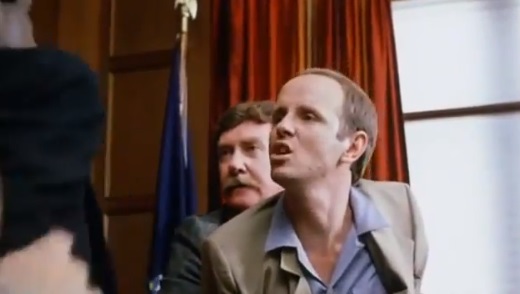
Moriarty gets his deal: a contract drawn up for all his demands and the money readied. “You already have the cash drawn up, right?” Moriarty says, calling the honchos’ bluff. And he’s willing to help beyond that, benevolent dude that he is — he suggests dropping a canvas over the building to trap Q (a stratagem Daniel Clamp would attempt in similar circumstances during Gremlins 2 a decade later). But the deal winds up biting Moriarty in the ass for legal, not moral reasons. He leads the cops to the nest, where they shoot the shit out of the egg and the cute wittle baby Q inside, but the contract he signed was not to provide the location of an egg, it was for the mama itself. No adult Q, no sale, Carradine tells him. “Stick it in your brain, your tiny little brain!” Moriarty replies, heading back to trash his girlfriend’s apartment in yet another fit of thwarted, powerless desire while Roundtree pursues some cult leads at the museum.
Carradine sticks around the nest. There could be a version of Q as straight horror procedural without Moriarty taking over and it would not be nearly as good, but it would work as long as Carradine was the lead cop. An old Army buddy of Cohen’s, he does excellent work selling all the cult hoodoo and stepping back to act as Moriarty’s straight man when he needs to, all while actually driving the plot — he’s the only authority figure for a long time who thinks this winged serpent thing might be real. And his persistence is rewarded, because Q — after going to the museum and chomping down on Shaft — comes back to the nest and is ready to fight.
In a magnificent oral history of Q by Will Harris at an old website, Cohen talks about showing up to Lost Arts Inc. with a fully-shot movie and telling them to plug in the monster. Effects heads Randy Cook and Dave Allen were horrified — they were supposed to be consulted about blocking and actor vs. monster placement, and the sequences were certainly not supposed to involve a camera swooping around on a god damn helicopter. And yet they make it work. This is the most extended screen time with have with Q, who is handled via stop-motion animation and looks awesome as a monster, but aesthetically would seem to make more sense fighting Sindbad the Sailor a decade ago. But the tactile monster combines with the shots of the actual Chrysler building and actual dudes hanging over its sides firing guns in the air to create something thrilling and true — the seams that show when knitting two real things together just makes the final product more real. Also, Q eats the shit out of a bunch of dudes before finally succumbing to machine-gun fire and a King Kong-like fall to the ground. If this is dreck, it is entertaining and involving and magical and you can stick sophistication in your brain, your tiny little brain.
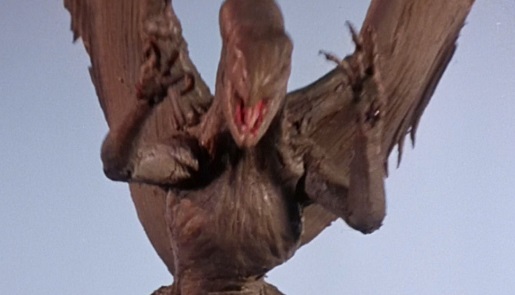
Speaking of long falls from the top, Moriarty is cooling his heels in a fleabag motel, kicked out by his girlfriend and bitterly muttering the line used as an epigraph above. What does he get for it, indeed? What Moriarty gets is the last cultist busting in and trying to sacrifice him, telling Moriarty to go willingly, to say the prayer that will give his death to Quetzalcoatl. Moriarty doesn’t have anything to bargain with, but for once he holds onto himself: “Piss on your prayer, I never say your goddamn prayers.” This gives Carradine, who has also been searching for Moriarty, enough time to come in and blow numerous holes in the cultist, who goes down and comes back as hard as Michael Myers before finally staying dead. Moriarty, on the other hand, is looking up. He’s going to get a job and get back together with his girlfriend, he tells Carradine. “I’m not afraid anymore!”
This happy ending is a tad off. It’s followed by a nicely cynical (and sequel-allowing) epilogue of another Q egg hatching, but that doesn’t quite mitigate the misplaced cheer. The theatrical version, which never made it to home video, apparently contains a final placard saying Moriarty successfully sued the city and got his $1 million anyway, and that feels much better. Moriarty’s self-actualization is seeded in the movie, but his full potential isn’t smiles and sunshine — it’s sticking it to the people who screwed him. If there’s anything in the movie he shares kinship with, it’s Q herself. They’re both just trying to live their lives while being harassed by cops and cultists, rattling around the city that never sleeps and won’t give anyone an even break. Q, a god, winds up dead in the street, but Moriarty is still fighting and pissing all over everyone. You don’t get rid of dreck that easily.

